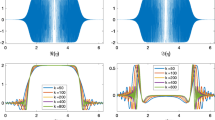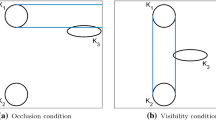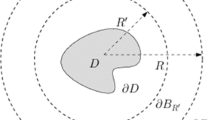Abstract
We introduce a class of hybrid boundary element methods for the solution of sound soft scattering problems in the exterior of two-dimensional smooth convex obstacles. To facilitate the applicability of our algorithms throughout the entire frequency spectrum, we have enriched our Galerkin approximation spaces, through incorporation of oscillations in the incident field of radiation, into the algebraic and trigonometric polynomial approximation spaces. The resulting methodologies have three distinctive properties. Indeed, from a theoretical point of view (1) they can be tuned to demand only an \(\mathcal {O}(k^{\varepsilon })\) increase (for any \(\varepsilon >0)\) in the number of degrees of freedom to maintain a fixed accuracy with increasing wavenumber k, owing to the optimal adaptation of approximation spaces to asymptotic stretching (shrinking) of illuminated and deep shadow regions (shadow boundaries), and (2) they are convergent for each fixed wavenumber k, thanks to the additional approximation spaces in the deep shadow region. Perhaps more importantly, from a practical point of view (3) they give rise to linear systems with significantly enhanced condition numbers and this, in turn, allows for more accurate solutions if desired.










Similar content being viewed by others
References
Abboud, T., Nédélec, J.-C., Zhou, B.: Méthode des équations intégrales pour les hautes fréquences. C. R. Acad. Sci. Paris 318, 165–170 (1994)
Abboud, T., Nédélec, J.-C., Zhou, B.: Improvement of the integral equation method for high frequency problems. In: Mathematical and Numerical Aspects of Wave Propagation: Mandelieu-La Napoule. SIAM, Philadelphia, pp. 178–187 (1995)
Amini, S., Profit, A.: Multi-level fast multipole solution of the scattering problem. Eng. Anal. Bound. Elem. 27, 547–564 (2003)
Anand, A., Boubendir, Y., Ecevit, F., Reitich, F.: Analysis of multiple scattering iterations for high-frequency scattering problems. II. The three-dimensional scalar case. Numer. Math. 114(3), 373–427 (2010)
Atkinson, K., Han, W.: Theoretical Numerical Analysis: A Functional Analysis Framework, Texts in Applied Math, vol. 39. Springer, New York (2009)
Banjai, L., Hackbusch, W.: Hierarchical matrix techniques for low- and high-frequency Helmholtz problems. IMA J. Numer. Anal. 28(1), 46–79 (2008)
Boffi, D.: Finite element approximation of eigenvalue problems. Acta Numer. 19, 1–120 (2010)
Bruno, O.P., Geuzaine, C.A.: An \({\cal O}\)(1) integration scheme for three-dimensional surface scattering problems. J. Comput. Appl. Math. 204, 463–476 (2007)
Bruno, O.P., Domínguez, V., Sayas, F.-J.: Convergence analysis of a high-order Nyström integral-equation method for surface scattering problems. Numer. Math. 124(4), 603–645 (2013)
Bruno, O.P., Kunyansky, L.A.: A fast, high-order algorithm for the solution of surface scattering problems: basic implementation, tests and applications. J. Comput. Phys. 169, 80–110 (2001)
Bruno, O.P., Geuzaine, C.A., Monroe, J.A., Reitich, F.: Prescribed error tolerances within fixed computational times for scattering problems of arbitrarily high frequency: the convex case. Phil. Trans. R. Soc. London 362, 629–645 (2004)
Bruno, O.P., Geuzaine, C.A., Reitich, F.: On the \({\cal O}\)(1) solution of multiple-scattering problems. IEEE Trans. Magn. 41, 1488–1491 (2005)
Chandler-Wilde, S.N., Graham, I.G.: Boundary integral methods in high frequency scattering. In: Engquist, F., Hairer, I. (eds.) Highly Oscillatory Problems, pp. 154–193. Cambridge University Press, Cambridge (2012)
Chandler-Wilde, S.N., Graham, I.G., Langdon, S., Spence, E.A.: Numerical-asymptotic boundary integral methods in high-frequency acoustic scattering. Acta Numerica 21, 89–305 (2012)
Colton, D., Kress, R.: Inverse Acoustic and Electromagnetic Scattering Theory. Springer, Berlin (1992)
Davies, R.W., Morgan, K., Hassan, O.: A high order hybrid finite element method applied to the solution of electromagnetic wave scattering problems in the time domain. Comput. Mech. 44(3), 321–331 (2009)
Domínguez, V., Graham, I.G., Smyshlyaev, V.P.: A hybrid numerical-asymptotic boundary integral method for high-frequency acoustic scattering. Numer. Math. 106(3), 471–510 (2007)
Ecevit, F., Reitich, F.: Analysis of multiple scattering iterations for high-frequency scattering problems. I. The two-dimensional case. Numer. Math. 114(2), 271–354 (2009)
Ganesh, M., Hawkins, S.: A fully discrete Galerkin method for high frequency exterior acoustic scattering in three dimensions. J. Comput. Phys. 230, 104–125 (2011)
Giladi, E.: An asymptotically derived boundary element method for the Helmholtz equation in high frequencies. J. Comput. Appl. Math. 198, 52–74 (2007)
Giladi, E., Keller, J.B.: A hybrid numerical asymptotic method for scattering problems. J. Comput. Phys. 174, 226–247 (2001)
Giladi, E., Keller, J.B.: An asymptotically derived boundary element method for the Helmholtz equations. In: Proceedings of the 20th Annual Review of Progress in Applied Computational Electromagnetics. Applied Computational Electromagnetics Society, USA (2004)
Gottlieb, S., Jung, J.-H.: Numerical issues in the implementation of high order polynomial multi-domain penalty spectral Galerkin methods for hyperbolic conservation laws. Commun. Comput. Phys. 5(2–4), 600–619 (2009)
Graham, R.L., Knuth, D.E., Patashnik, O.: Concrete Mathematics. A Foundation for Computer Science. Addison-Wesley Publishing Company, Reading (1994)
Hesthaven, J.S., Warburton, T.: High-order accurate methods for time-domain electromagnetics. CMES Comput. Model. Eng. Sci. 5, 395–408 (2004)
Huybrechs, D., Vandewalle, S.: A sparse discretization for integral equation formulations of high frequency scattering problems. SIAM J. Sci. Comput. 29(6), 2305–2328 (2007)
Keller, J.B.: Geometrical theory of diffraction. J. Opt. Soc. Am. 52, 116–130 (1962)
Keserci, S.: Analysis of convergent integral equation methods for high-frequency scattering. M.S. Thesis, Boğaziçi University, Istanbul (2012)
Kress, R.: Linear Integral Equations, 2nd edn. Springer, New York (1999)
Melrose, R.B., Taylor, M.E.: Near peak scattering and the corrected Kirchhoff approximation for a convex obstacle. Adv. Math. 55, 242–315 (1985)
Namburu, R.R., Mark, E.R., Clarke, J.A.: Scalable electromagnetic simulation environment. CMES Comput. Model. Eng. Sci. 5, 443–453 (2004)
Özen, H.Ç.: Robust high-frequency solvers. M.S. Thesis, Boğaziçi University, Istanbul (2012)
Schwab, C.: p- and hp-finite element methods. In: Theory and Applications in Solid and Fluid Mechanics. Oxford University Press, Oxford (1998)
Sherer, S.E., Visbal, M.R.: Time-domain scattering simulations using a high-order overset-grid approach. In: Proceedings of the 2005 IEEE Workshop on Computational Electromagnetics in the Time-Domain, pp. 44–47 (2005)
Spence, E.A., Chandler-Wilde, S.N., Graham, I.G., Smyshlyaev, V.P.: A new frequency-uniform coercive boundary integral equation for acoustic scattering. Commun. Pure Appl. Math. 64(10), 1384–1415 (2011)
Taflove, A., Hagness, S.: Computational Electrodynamics: The Finite-Difference Time-Domain Method, 3rd edn. Artech House, Boston (2005)
Timan, A.F.: Theory of Approximation of Functions of a Real Variable. Dover Publications, USA (1994)
Tong, M.S., Chew, W.C.: Multilevel fast multipole acceleration in the Nyström discretization of surface electromagnetic integral equations for composite objects. IEEE Trans. Antenn. Propag. 58(10), 3411–3416 (2010)
Acknowledgments
The first author would like to thank Simon Chandler-Wilde (Reading), Víctor Domínguez (Tudela), Ivan G. Graham (Bath), and Valery Smyshlyaev (London) for useful discussions.
Author information
Authors and Affiliations
Corresponding author
Additional information
This work is supported by Boğaziçi University Scientific Research Fund Grant Number 5548P.
Auxiliary results
Auxiliary results
Lemma 2
(A partial fraction decomposition) Given \(c \ne d\), we have the partial fraction decomposition
valid for all \(s \in \mathbb {R} \backslash \{c,d\}\) and all \(m \ge 1\).
Proof
The case \(m=1\) corresponds to the decomposition
and its yields, by a straightforward induction, the identities
and
for all \(j \in \mathbb {N} \cup \{ 0 \}\). Therefore, by induction on m, we get
which we rewrite as
Changing the order of summation in the double-sum yields
so that a rearrangement gives
Since [24, page161]
we have
and
Therefore
and this is easily seen to correspond to the given formula for \(m+1\). \(\square \)
Lemma 3
Suppose that either \([\alpha ,\beta ] \subseteq [t_{1},t_{2}] \subseteq (c,d)\) or \([\alpha ,\beta ] \cap (t_{1},t_{2}) = \varnothing \) and \([c,d] \subseteq (t_1,t_2)\). Then, for any \(a,b \in \mathbb {R}\), \(n \in \mathbb {N} \cup \{ 0 \}\), \(m \in \mathbb {N}\), there holds
Here we have
when \(2n-(p+q+j) = -1\), and
when \(2n-(p+q+j) \ne -1\).
Proof
Lemma 2 entails
Changing variables, we get
so that an appeal to the binomial theorem yields
Thus the result. \(\square \)
Rights and permissions
About this article
Cite this article
Ecevit, F., Özen, H.Ç. Frequency-adapted Galerkin boundary element methods for convex scattering problems. Numer. Math. 135, 27–71 (2017). https://doi.org/10.1007/s00211-016-0800-7
Received:
Revised:
Published:
Issue Date:
DOI: https://doi.org/10.1007/s00211-016-0800-7




